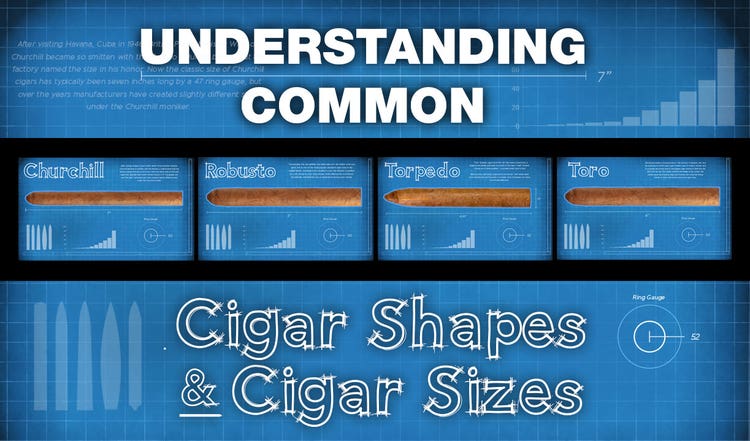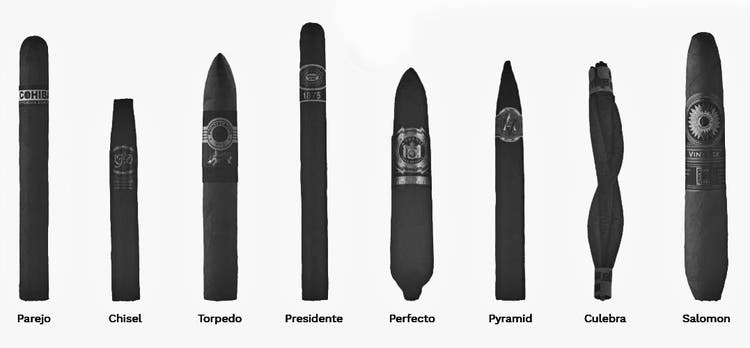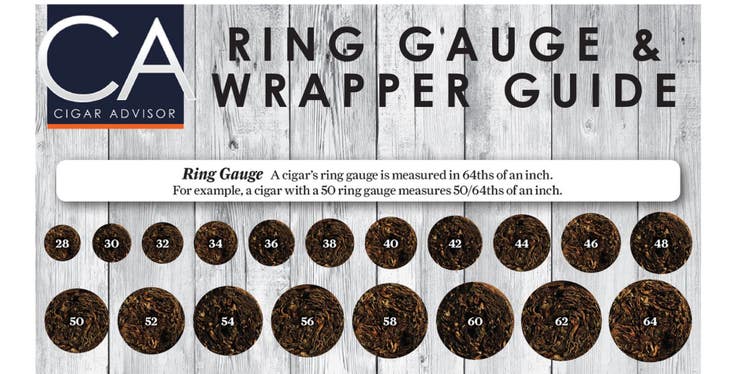
2021 CA REPORT: Understanding Common Cigar Shapes and Cigar Sizes
Any enthusiast’s humidor is likely to be stocked with a number of cigars of different shapes and sizes. Usually, cigar enthusiasts tend to favor one vitola (a Spanish term that’s become a catchall phrase for different cigar shapes and sizes)—but you’ll find plenty of others as well. And whether you’re new to cigars or an old pro, we’ve all wondered at one point, “why are there so many shapes and sizes?”
Physical dimensions —length, width, and shape—are among the most common ways to group cigars. Length is measured in inches, width is in ring gauge. And cigar shapes fall into 2 main categories: Parejos and Figurados. But before we get to that, let’s talk about ring gauge.
How Cigar Ring Gauge is Measured
Ring gauge measures the thickness of a cigar in 1/64ths of an inch. That means a cigar with a ring gauge of 64 is one inch in diameter, and a 32-ring gauge measures in at ½ inch. They don’t stop at just 64 though: you can easily find cigars coming in at ring gauges as large as 70, 80, or even 90.
It’s reasonable to wonder whether cigar thickness affects a blend’s strength. The short answer is no—or at least, not really. Because body is often perceived as strength, a thicker cigar usually won’t be any stronger in a larger ring gauge. However, larger ring cigars deliver more flavors – or complexity – because they contain more premium long-filler leaf. So, if you really love the flavors in a cigar like the Jaime Garcia Reserva Especial Robusto, then try the blend in a Toro Gordo or Super Gordo for more of that rich maduro goodness.
If you’ve found that you enjoy cigars because of their exceptionally flavorful wrappers (like the Southern Draw Cedrus for example), try it in a smaller ring gauge like a Lancero. Because thinner cigars have a greater ratio of wrapper to binder and long-filler, it really brings out the heart of that valued leaf.
What are the Most Common Cigar Shapes
When it comes to shapes, most cigars are either Parejos or Figurados.

If you imagine a cigar, you’re thinking of a Parejo. The Parejo—Spanish for “even”—is a cigar with straight, parallel sides. Parejos can be round—like a tube—or box-pressed, which are cigars with straight sides that are flat as opposed to rounded.
Figurados are cigars that usually taper at one end, like Torpedoes. You might notice that with Figurados the ring gauge is two numbers with a slash separating them (40/54). These two numbers indicate the cigar (in this example) starts out at a 40 ring and progresses to a 54. And some, called Perfectos, taper at both ends.
There are a few cigars that fall outside the standard Parejo or Figurado categories. The most common of these unusual shapes is the Culebra: three thin cigars that are intertwined, then tied at the ends by ribbon or string. They’re made to be untwisted and shared but are most often kept as a rarity or conversation piece. Through the years makers have released limited cigars in other ‘novelty’ shapes like eggs, tobacco pipes, footballs, saxophones, and more.
Here are the most common cigar shapes and sizes with their measurements in parentheses. To be accurate, I’ve listed the approximate ranges for each size as cigar factories differ in their exact dimensions.
The Most Common Parejo Cigar Shapes and Sizes
Many enthusiasts love box-pressed cigars because they’re easier to stack in a humidor. They’re among the best sellers and you’ll commonly find them in sizes like Robustos and Toros. Most brands make box-pressed cigars, and you can’t go wrong with this under-the-radar Sancho Panza Extra Fuerte.
Usually considered comparable to a cigarette, premium handmade cigarillos couldn’t be more different than their machine-made counterparts. Small premium cigars like the Drew Estate Liga Privada No 9 are perfect for those moments—like a commute or cold weather—when your time to enjoy a cigar is limited.
This cigar size was born in Cuba during the 1960’s, and initially only made for Fidel Castro. Now, with a rabid and growing fanbase, Lanceros – like this El Gueguense – are having their moment. Made by Drew Estate veteran Nick Melillo, it displays an artful balance of hand selected tobaccos.
Common wisdom once held that the Corona was the best cigar size to taste the blender’s intent. While this no longer holds 100% true, Coronas remain popular. Their short stature and thinner ring gauge make them a great choice for the time pressed: this Long Live the King by Caldwell offers a 45-minute feast for your senses.
Hands down, the most popular size on the market today. For many enthusiasts this shape is the perfect vitola, and many more use it to ‘try out’ a new blend. This Camacho Corojo Robusto is hearty and smooth with a perfect balance of spicy, sweet, and savory.
The Toro has taken over for the Corona in master blenders’ taste tests, as these longer and fatter cigars have a good proportion of wrapper to long filler to length of the cigar. In the hands of a master like AJ Fernandez, the Romeo y Julieta Montague displays a flawless proportion of flavor and complexity.
Named for Sir Winston, this size is renowned for delivering a longer and cooler smoking experience; the Churchill’s length allows the smoke to cool on its way to your palate. The Partagas Fabuloso is a must try cigar that shall be smoked on the beaches, smoked in the fields and in the streets, smoked in the hills, and shall never surrender.
The Most Common Figurado Cigar Shapes
Torpedo cigars taper to a point at one end. Enthusiasts love them because even with a larger ring gauge, they’re still easy to clench between your lips. How deep you cut the head determines how intense the smoke will be, even from a good everyday Torpedo like the Baptiste. Made by Oliva, it’s an engaging, complex and affordable cigar.
This classic cigar shape reminds me of old timey gangsters or Wall Street types. Tapered at both ends, this shape is not as common today, but worth seeking out because of the complexity that the different widths provide as the perfecto progresses. Many enthusiasts consider the Arturo Fuente Hemingway series among the perfect Perfectos.
It’s likely you’ve already discovered that certain blends taste better to you in different shapes. Keep experimenting and—if you haven’t already—try some of the sizes I’ve discussed above. Maybe you’ll find a few new vitolas to add to your cigar collection.









